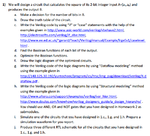LavezLas
Newbie level 5

- Joined
- Apr 4, 2013
- Messages
- 8
- Helped
- 0
- Reputation
- 0
- Reaction score
- 0
- Trophy points
- 1,281
- Activity points
- 1,337
Hi guys,
First of all, I'm glad that I'm a part of this forum by this day.
Here is my question; teacher wants us to design a circuit that calculates the square of its 2-bit integer input A=(a1,a0) and
produces the output B. He wants verilog codes with 3 types;
1)Write the Verilog code by using “if” or “case” statements
2)Write the Verilog code of the logic diagrams by using “Dataflow modeling” method
3)Write the Verilog code of the logic diagrams by using “Structural modeling” method
I think it will be very easy for you, a quick reply would be very nice
First of all, I'm glad that I'm a part of this forum by this day.
Here is my question; teacher wants us to design a circuit that calculates the square of its 2-bit integer input A=(a1,a0) and
produces the output B. He wants verilog codes with 3 types;
1)Write the Verilog code by using “if” or “case” statements
2)Write the Verilog code of the logic diagrams by using “Dataflow modeling” method
3)Write the Verilog code of the logic diagrams by using “Structural modeling” method
I think it will be very easy for you, a quick reply would be very nice


